Tobacco use is a significant public health issue worldwide, affecting millions yearly. According to the most recent figures, approximately 30.8 million Americans (12.5% of adults) smoked cigarettes in 2020—14.1% of men and 11% of women specifically. This figure has only grown in recent years, indicating that the need for more healthy habits and lifestyle choices is becoming more urgent. This article will discuss the effects of smoking and other tobacco products on your overall dental health.
1. Tooth Decay
Smoking and other tobacco products contribute to the development of tooth decay in several ways. Firstly, the tar and nicotine found in cigarettes, cigars, and chewing tobacco are highly acidic, weakening enamel and creating an environment where bacteria can thrive. Additionally, smoking causes a decrease in saliva flow which is vital for maintaining healthy teeth as it helps to wash away food particles and bacteria. As a result, smokers are more likely to experience tooth decay and other oral health issues such as cavities.
An essential factor in the development of tooth decay is poor oral hygiene, which is common among smokers. This includes not brushing or flossing regularly, eating sweetened snacks between meals, and not visiting the dentist for regular checkups. By neglecting proper oral hygiene habits, smokers are more likely to develop cavities and other dental problems.
One way to address the issue of tooth decay and other dental problems caused by smoking is through the use of dental implants. Implants are prosthetic teeth surgically inserted into the jawbone and can restore both form and function to missing or damaged teeth. The implant acts as an artificial root, anchoring a replacement crown, bridge, or denture and preventing further decay.
2. Periodontal Disease
Periodontal (gum) diseases are caused by a buildup of plaque on the teeth and gums, leading to an infection of the bone and soft tissues supporting the teeth. Smoking or chewing tobacco products can interfere with proper blood flow and oxygen levels in the mouth, which leads to a higher risk for periodontal disease. Additionally, chemicals found in smokeless tobacco can weaken gum tissue and make it more susceptible to inflammation and infection.
Common signs of periodontal disease include red, swollen gums that may bleed when brushing or flossing. Bad breath and a bad taste in the mouth are also common indicators. Loose teeth, receding gum lines, and shifting teeth can occur as the infection progresses. Left untreated, these issues can lead to tooth loss and an increase in oral health problems.
Treatment for periodontal disease often involves a deep cleaning called scaling and root planing, which removes plaque from below the gum line. Depending on the severity of the infection, antibiotics may be prescribed to reduce or eliminate bacteria that are contributing to the disease. In more severe cases, surgery may be necessary to restore the gums and supporting structures around the teeth.
3. Dry Mouth

Smoking and other tobacco products reduce saliva flow in the mouth, leading to dry mouth (xerostomia). Saliva helps protect against tooth decay by washing away food particles, neutralizing acid, providing minerals to help rebuild enamel, and helping prevent plaque buildup. When saliva flow is reduced, these protective benefits are lost, leading to an increased risk for tooth decay.
Dry mouth can also contribute to gum disease and other serious dental problems. Without saliva, food particles remain on teeth, providing a source of nutrition for bacteria which can lead to plaque formation and gum inflammation. Periodontal disease is a common issue linked with dry mouth as it is caused by bacteria that build up due to the lack of saliva. Maintaining good oral hygiene and regularly visiting a dentist if you have dry mouth is essential.
The most common treatment for dry mouth includes drinking plenty of water and keeping the tissues in your mouth moist by using oral lubricants such as gels, sprays, and lozenges. You can also use certain prescription medications to help increase saliva production. If your dry mouth is caused by a medicine you are taking, talk to your doctor about the possibility of changing medications or reducing the dosage.
4. Staining
Tobacco use can also lead to teeth staining and discoloration of the gums and tongue. Tar and nicotine in cigarettes and smokeless tobacco products stick to the surfaces of the teeth, making them appear yellow or brown. This type of staining is difficult to remove with traditional at-home brushing and flossing techniques, so professional dental cleaning may be necessary to restore a brighter smile.
Discoloration of the gums and tongue can also result from long-term tobacco use. Nicotine in cigarettes, cigar smoke, and chewing tobacco can cause changes in gum color and texture. The gums may appear a darker shade of pink or even gray if they are heavily exposed to nicotine over an extended period. In addition, the tongue can become discolored and covered in a white, yellow, or brown coating due to smokeless tobacco use.
These stains and discolorations are not only unsightly but also can be indicative of more serious oral health problems. People using tobacco products for extended periods should discuss the issues with their dentist and inquire about professional tooth whitening treatments or other options. It is important to remember that not all stains can be removed, so it is necessary to consult a dental professional for the best possible results.
To Wrap It Up
The effects of smoking and other tobacco products on tooth decay can be significant. Research suggests that these substances increase the risk for cavities, periodontal disease, dry mouth, staining, and other oral health issues. Practicing good dental hygiene habits is important regardless of whether you use tobacco products. If you do smoke or chew tobacco, quitting is the best way to reduce your risk for tooth decay and other oral health problems.



